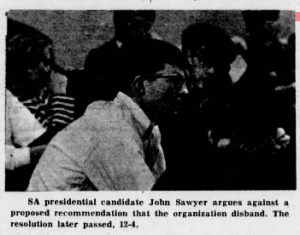A Brief Timeline of the Middlebury Student Government Shutdown
The Prelude to Dissolution
Middlebury’s Student Association members began to circulate the idea of government dissolution after seeing the growing discontent with their power relationship with the administration and the association’s structure. In the Feb 15. Issue of The Campus SA Member Barney Maier, “it is the structure of the [association] which presents the problem.” He went on to describe the Association as “a showcase on a sounding board, and that it [the association] has little power “. Without power, Association members felt useless and began to question if the group should even continue to be the face to the administrations decisions. Arguing for dissolution SA members Susan Walker, and Maier also claim that “student demands are more likely to be acted upon if the administration is pressured by mass-supported protest”, or in this case wide-spread support for dissolution.
The Powerless Act
In a 12-4 vote, the Student Association voted to conduct a student-wide referendum calling for their dissolution should a majority of the student body vote for it. According to Barry Sullivan, a writer for The Campus, the meeting largely focused on “whether the present close relationship between student leader and administrator fostered in a formal system such as the SA was detrimental to the best interests of the student body.” In that same article SA member Brian Maier stated, “we must take power rather than ask for it. We must take power responsibly whether the administration agrees with us or not. The administration will not give power to us and there is no alternative to taking power on a subversive basis.” The members went on to demand that the body no longer be a token government but one that can truly serve as an advocate for the student body against to the administrations.
Protest Brings New Power, and Forgotten Responsibilities
The Middlebury student body overwhelmingly votes, 407-70, to dissolve the Student Association. Almost immediately afterwards the administration begins talks to reinstate the group, or replace it by the existing Student Life Committee. After the body dissolved well-endowed student groups like WRMC and The Campus began to worry about their ability to continue publication and broadcast respectively due to the lack of continuing funding from the now defunct Student Association. After funding issues came to a head with e the budget for the next year, students and administrator talks were successful establishing the Student Government Association. Student Government Association powers included sought-after terms like student representation on faculty committees and broader legislative ability. By-in-large the dissolution proved successful.

